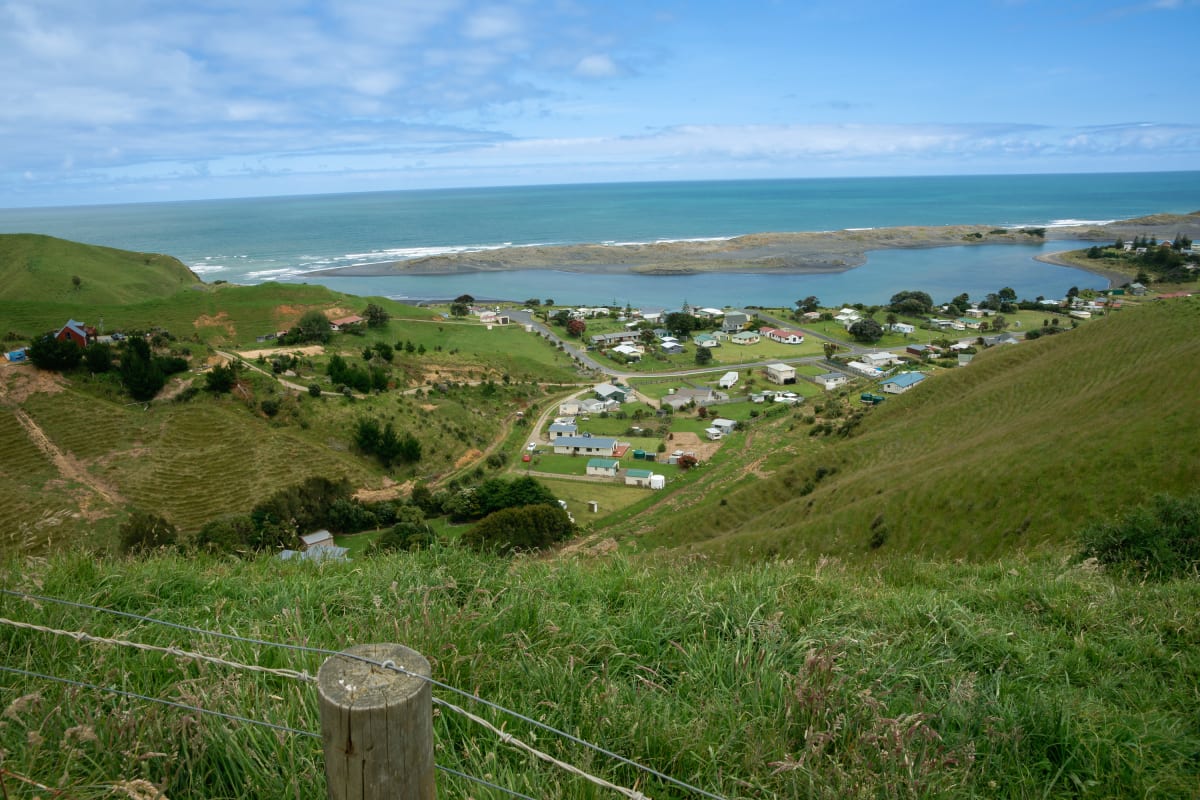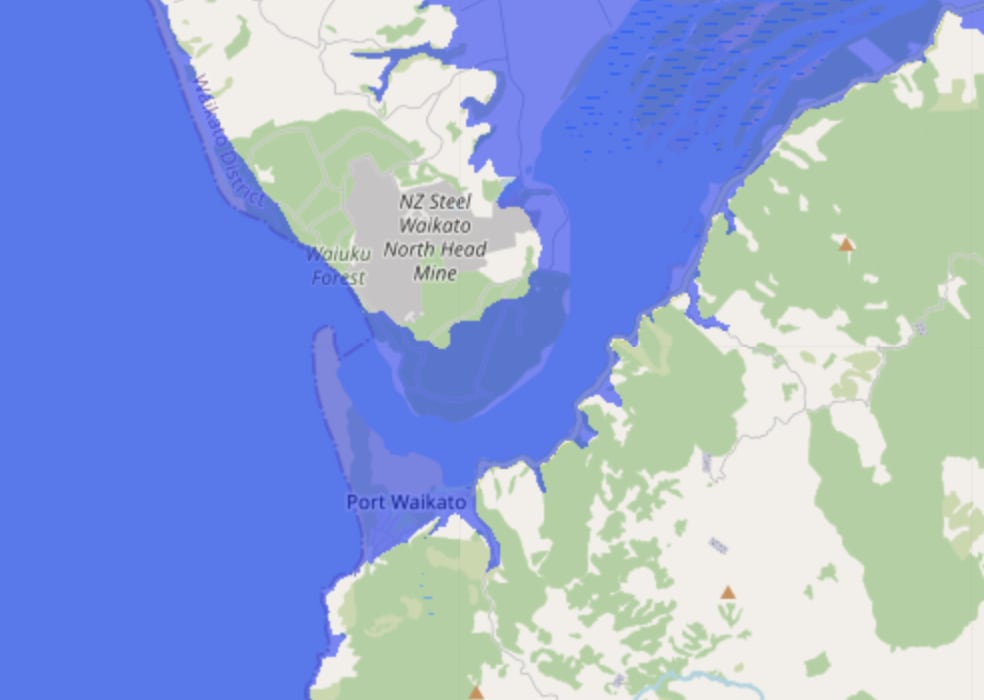
Storm-battered Port Waikato residents say they feel neglected as they begin the slow walk to recovery
As residents of a small coastal town in the northwestern corner of Waikato begin to round the corner from the impact of Cyclone Gabrielle, they say they have felt “neglected” by Waikato District Council and government response efforts.
Port Waikato was hit by simultaneous land slips and flooding following last week’s weather event, leading to the evacuation of residents and red and yellow placards preventing reentry into damaged homes.
READ MORE: * Piha's floodwaters take on formerly crowded house * When the water keeps coming
As of last Tuesday, roads in the township were underwater and access to the wider world had been cut off by the mix of floods and slips.
But while the beachside community has been able to begin the long road to recovery, locals say the council and its approach to local infrastructure maintenance hasn’t been much help.
Mike McCormack is the acting senior station officer at Port Waikato Volunteer Fire Brigade. He spent the last week pumping water out of houses.
Destruction wreaked in a Port Waikato house
He said the back and forth from the council and Watercare had slowed his team’s ability to get the town sorted, as well as left locals feeling left out in the cold.
“There are houses with slips behind them and houses that have had water in them,” he said. "People are feeling abandoned and no one’s happy with the support they’ve been given by our council, full stop.”
A council-sent vacuum truck and a digger arrived yesterday to help with slip-clearing and flood-draining, but McCormack wants to know why it took more than a week for them to arrive.
And while the bulk of the private home pumping has been done by the fire brigade, higher-ups have just recently ordered them off the job.
“The initial emergency is over so I’ve been told we are not to pump water out of private properties because it's not Fire & Emergency’s responsibility,” he said. “Well as far as I'm concerned, that's what you do for your community.”
According to McCormack, the organisation wanted firetrucks back at the station and ready for acute emergencies rather than helping with community recovery, and was willing to throw some veiled threats his way in case he didn’t comply.
“I was told you pull those pumps, take them back to the station or think about your career,” he said. “Well I'm a volunteer, mate. They pay $300 a year so they can call us an employee. I have an employee number but I'm a volunteer - I’m 61 years of age!”
McCormack acknowledged there had been some breakdowns in communication between individual stations and the broader organisation.
“Yes, I understand there's been a bit of a breakdown in communication between us and FENZ,” he said. “But the comms centre mucked that up, not me.”
Outside of FENZ, McCormack said it had been difficult getting hold of pumps big enough to drain the water that’s covering parts of the town.
An initial request to Watercare for a generator and a large pump was cancelled, with Watercare staff saying the town’s current infrastructure should be up to the task.
“His reasoning was that the drainage system and the pump system in Port Waikato were more than adequate for any surface water. Well, they weren’t,” he said.
McCormack said it was an ongoing problem of drainage repair and maintenance that the council needed to address.
“We need the council to actually fulfil the promises that they've made in the past and do what they said they were going to do: fix our drainage system,” he said. “Admittedly, Waikato District Council has inherited a badly maintained water drainage system from Franklin District Council, but they've owned it for more than 10 years and they've done nothing.”

Port Waikato’s National Party MP Andrew Bayly said there were aspects of the dual council response within his electorate that he commended, but also some things that could have been done better that he would bring up when the time was appropriate.
“There are parts of what council have done that’s been very good, and even on the road down to Port Waikato there were significant numbers of slips on a couple of occasions and I think the Waikato District Council did a good job in responding to those slips,” he said.
However, he had issues with how alerts were broadcast - especially over the river in the Auckland patch of his electorate, where people in Pukekohe and surrounds didn’t receive cellphone alerts they were supposed to.
There were significant patches of Franklin where alerts simply weren’t coming through,” he said. “Very disappointing from that perspective.”
Another issue he noted was the lack of council involvement in setting up community hubs.
“In Pukekohe, one of the local board members took it upon themself to set up a community hub,” he said. “It was staffed by Pukekohe Community Patrol… we had volunteers in places like Waiuku.”
Institutions like a marae in Waiuku and a kura in Port Waikato opened their doors to give people shelter, as well.
“But largely those were voluntary organisations and people committing their time - there was no formal structure,” he said. “We were told we were left on our own and get on with it. There were no resources available.”

Jade McCormack (Mike’s daughter-in-law) is the manager of the Port Waikato Holiday Park, as well as chair of the Port Waikato Resilience Group.
She said she had been trying to get more frequent clearing and maintenance of local drains, even before this summer’s storms, to little avail.
It’s a call she’s doubling down on given how long it's taken to get the water out from her own property and the neighbouring area.
“We’ve had a lot of flooding in the park, some of it due to the lack of drainage on Maunsell Road,” she said. “There’s definitely an issue with drainage maintenance out here – we’ve had people trying to get Watercare to maintain our drains for quite a long time.”
Feelings of abandonment were exacerbated last Monday when council was slow to react to requests for a generator and a pump to start clearing the floodwaters.
Road closures and access issues were given as a reason the pump couldn’t get out to the town - but McCormack isn’t so sure that holds water. On that very same Monday, police were able to get out to the town despite concerns about the safety of bridges in the area.
That same day the Karaka-based Ngāti Tamaoho Charitable Trust sent a pump their way, although McCormack said it was too small for the job.
Residents of Port Waikato doing it for themselves.
The drainage systems of Port Waikato are supposed to take stormwater and deliver it straight into the Waikato River, just before it flows into the ocean.
The immense quantity of water last week saw those drains quickly blocked, however. Local fire brigades were able to begin pumping flooded homes out with their own pumps, but once this water joined the rest out on the streets of Port Waikato, there was nowhere for it to go.
An industrial-sized pump would be needed to actually make a dent in the floodwaters.
A lack of access to heavy-duty pumps has been an issue that’s come up over and over again in the past week - for example, the greenish waters that collected last week on Garden Road in Piha couldn't be seen to until Auckland Emergency Management sent out a big enough pump.
But down in Port Waikato, Watercare representatives told a meeting of residents they may not need a new pump on the Tuesday, and said they would need to come out for a site inspection before one could be arranged.
“We’ve definitely been feeling neglected with our drainage system and maintenance and all of that,” McCormack said. “We'd like better maintenance on our system and probably an upgrade.”
Waikato District Civil Defence controller Kurt Abbot said Port Waikato was the hardest-hit area in the district and commended the local community response, especially that of the fire brigade.
Other community players included the people at Te Kura Kaupapa Māori o Te Puaha o Waikato, who established a community-led shelter to look after displaced people.
However, he said the council had done its bit in propping up the community response.
“The Waikato District Council Civil Defence team have been supporting the community during and since the cyclone,” he said. “But we want to stress our appreciation of the community’s effort to support each other and the work they have put in for their own clean-up efforts.”
According to Abbot, the biggest problems in Port Waikato right now are standing floodwater due to saturated ground, blocked drains and low-lying areas where it has pooled, and the ground stability, specifically slips behind properties in Maunsell Road.
“Diggers are out there this week clearing a couple of slips behind properties on Maunsell Road in areas where they have blocked drains so as surface water can flow.”
Homeowners in the affected area told Newsroom that the council had been slow to get there and begin clean-up on the huge slip in their backyard that’s been further blocking the drainage system.
Work began today by a 1.7 tonne digger and truck to clear slips behind two properties on Maunsell Road.
Contractors expect to clear 30 to 40 m3 of built-up slip deposits, but say it’s only a short-term solution. According to the council, a long-term fix is under investigation.
“Recovery is ongoing and will continue for a while yet,” Abbot said. “While many have made progress with recovering from the floodwater and slips in Port Waikato, we have many properties that remain uninhabitable.”

The town already has experience dealing with the potential issues of coastal erosion - an existential threat vivid enough that council and residents’ groups have worked together to create a strategy plan to help it deal with inevitable future disasters.
The decision to call a state of emergency for the area last week took the Port Waikato area into account in risk assessment models, which indicated there was a high hazard risk to low-lying areas near the Waikato River at Port Waikato.
But as towns like Port Waikato begin the slow march down the long road of recovery, questions of the resilience of infrastructure are not going to go away.
Abbot said the council will be there to work with them on these issues.
“We will work with local communities across the district to support them in refining their community response plans,” he said. “We will work with government and supporting agencies to plan for short, medium and long-term needs of our communities and what we may need to do different to build back better.”
But when it comes to the people of Port Waikato, trust may not be so easy to win back for the Waikato District Council.







